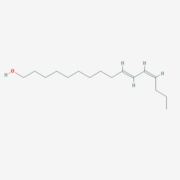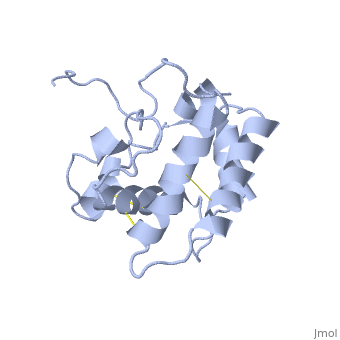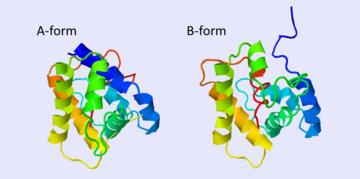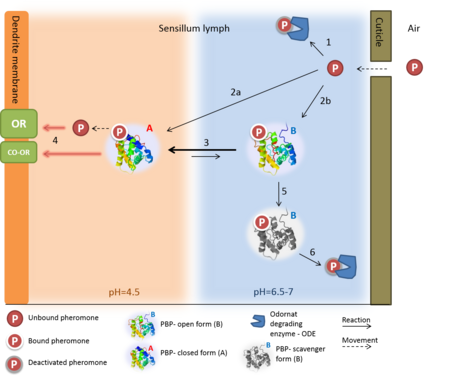Odorant binding protein
From Proteopedia
| Line 50: | Line 50: | ||
'''Conformation transition mechanism:''' | '''Conformation transition mechanism:''' | ||
| - | The c-terminus of the protein bears mostly non-polar amino acids. Yet on the surface of the helix there are three exceptional amino acids: Asp-132, Glu-137, and Glu-141, which are conserved in moth PBP <ref>doi: 10.1016/j.bbrc.2005.07.176</ref>. Of these, residues <scene name='68/683383/Bombykol_ligand_in_2p71/2'>Asp-132</scene> (and Glu-141, if present) triggers the formation of the alpha-helix upon protonation at low pH. This causes the ejaculation of the ligand from the binding pocket, which is replaced by the formatted alpha helix<ref>doi: 10.1016/j.bbrc</ref>. | + | The c-terminus of the protein bears mostly non-polar amino acids. Yet on the surface of the helix there are three exceptional amino acids: Asp-132, Glu-137, and Glu-141, which are conserved in moth PBP <ref>doi: 10.1016/j.bbrc.2005.07.176</ref>. Of these, residues <scene name='68/683383/Bombykol_ligand_in_2p71/2'>Asp-132</scene> (and Glu-141, if present) triggers the formation of the alpha-helix upon protonation at low pH. This causes the <scene name='68/683383/1dqe_2fjy-bom/1'>ejaculation of the ligand from the binding pocket</scene>, which is replaced by the formatted alpha helix<ref>doi: 10.1016/j.bbrc</ref>. |
| + | |||
| + | {{Button Toggle AnimationOnPause}} | ||
| + | |||
Studies on other Lepidopterans that show a similar pH dependent conformation suggests that this model is a general model moth PBP<ref name="Leal" />. | Studies on other Lepidopterans that show a similar pH dependent conformation suggests that this model is a general model moth PBP<ref name="Leal" />. | ||
Nonetheless, the enormous diversity among insects is not allowing us to assume this model is true for all insects' OBPs. | Nonetheless, the enormous diversity among insects is not allowing us to assume this model is true for all insects' OBPs. | ||
| - | [[Image:N model extended.png|thumb|upright=2.5|Figure 1. The events prior the neuron excitation, following the "N model" suggested by Kaissling (2009)<ref name="Kaissling 2009" />: The pheromone enters the sensillar lymph through a pore in cuticle. Following entrance the pheromone can be degraded by the ODE (1) -or- bind to the A and B protein forms (2a and 2b, respectively). The transition between the two forms in the neutral pH of the lymph, is in favor for the B form in the presence of the ligand (3). However, when the complex arrives at the low pH near the membrane, the transition is in favor of the A-form, (4) in which the | + | [[Image:N model extended.png|thumb|upright=2.5|Figure 1. The events prior the neuron excitation, following the "N model" suggested by Kaissling (2009)<ref name="Kaissling 2009" />: The pheromone enters the sensillar lymph through a pore in cuticle. Following entrance the pheromone can be degraded by the ODE (1) -or- bind to the A and B protein forms (2a and 2b, respectively). The transition between the two forms in the neutral pH of the lymph, is in favor for the B form in the presence of the ligand (3). However, when the complex arrives at the low pH near the membrane, the transition is in favor of the A-form, (4) in which the pheromone is ejaculated due to the change in conformation - c-terminus is pushing out the ligand. The activation of the complex of odorant receptor and coreceptor (OR:OR-CO), is induced by ether the complex of pheromone-PBP, or by the pheromone alone (5, two options). The B-form can also act as a scavenger, as it mediates the deactivation of the pheromone (6) and releases it to the ODE (7)]] |
====Receptor activation==== | ====Receptor activation==== | ||
Two theories have been proposed for the activation of the odorant receptors located on the dendrtirte membrane. One theory suggests that the pheromone-PBP complex is needed for the receptor activation, while the second theory argue that the pheromone itself is sufficient for the activation of the receptor. | Two theories have been proposed for the activation of the odorant receptors located on the dendrtirte membrane. One theory suggests that the pheromone-PBP complex is needed for the receptor activation, while the second theory argue that the pheromone itself is sufficient for the activation of the receptor. | ||
Revision as of 10:09, 16 January 2015
Contents |
Introduction
Odorant-binding protein (OBP) are soluble proteins which involve in the processes of odorant detection in the olfactory sensilla.
Though functionally same, vertebrates and insects OBP have different origin and structure. OBPs are important for insect olfaction. For instance, OBP76a (LUSH) in the fly Drosophila melanogaster is required for the detection of the pheromone vaccenyl acetate [Ha and Smith, 2006; Xu et al., 2005] and has been proven to adopt a conformation that activates the odorant receptor [Laughlin et al., 2008].

OBP in insects
OBP Function
Despite five decades of intensive research, the exact roles of OBP and the mechanism by which the odorant receptor (OR) is activated are still in dispute [1][2].
A few functions have been suggested for OBP: 1. Solubelizing the odorant molecule and its transportation in the sensillar lymph.
2. Protecting the odorant molecule from the odorant degrading enzymes, in the sensillar lymph.
3. Activating of the odorant receptor on the dendrite membrane, by the odorant-OBP complex.
4. Mediating the deactivation of the odorant molecule after the activation of the receptor.
5. An organic anion (the protein has 9 negative charges).
Of all, the first role of OBP as an odorant solubilizer and carrier is generally accepted.
In order to explain the structure and function of these fascinating proteins, this page will further focus on a particular OBP - the well investigated Bombyx mori PBP: BmorPBP.
Bombyx mori BmorPBP (lets talk about sex..)
| |||||||||||
See also
- Odorant_binding_protein_3D_structures
- Chemical communication in arthropods
- Pheromone binding protein
References
Proteopedia Page Contributors and Editors (what is this?)
Nurit Eliash, Michal Harel, Joel L. Sussman, Alexander Berchansky, Jaime Prilusky



